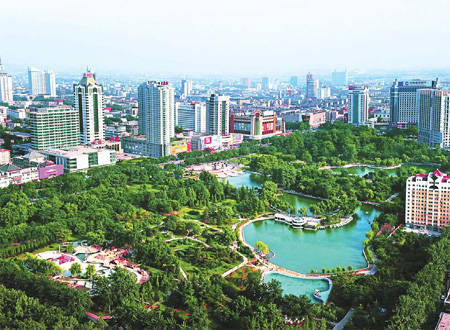Ceramics capital continues to shine
 |
| Zibo was called Linzi in ancient times, when it was the capital of the Qi state more than 2,000 years ago. |
Ceramics have been made in the city of Zibo in Shandong province for more than 1,000 years and the tradition lives on today with many of its products used by State leaders and government organizations, or as state gifts to foreign guests.
Its most famous product in recent times is the "Chinese Dragon" - a tea set specially designed by craftsmen in Zibo to mark China's 50th national day in 1999.
The setting is used in the Great Hall of the People, the Diaoyutai State Guesthouse and Zhongnanhai - the central government complex.
The city's producers of fine tableware include Zibo Guiyuan New Material Co Ltd, which makes cups of high-purity quartz china that have been used by China's top leaders for 26 years .
Guiyuan is only one of some 300 companies in Zibo that make ceramic products frequently used by government organizations since the 1970s.
Zibo-made ceramics are also used as gifts to foreign guests.
Their artistic value has led international museums and galleries including the Art Institute of Chicago and the Canberra Museum and Gallery to include them in collections.
850m items annually
Zibo now has five ceramics sectors that produce household porcelain, ceramics for high-tech use, building ceramics, ceramics machinery and fire-resistant ceramics. Together they annually make products valued at 10 billion yuan.
The biggest commercial player of the five, the household porcelain sector, has 150 companies that produce 850 million items annually. They generate 4.2 billion yuan in combined annual revenue, which ranks Zibo as the second-largest household porcelain producing city in China.
More than 20 billion yuan worth of ceramics is sold in Zibo each year, due in part to its many industry shows and fairs.
The annual Zibo International Ceramics Exposition which began in 2001 is the most well-known as a venue for ceramic businesses worldwide to showcase their latest products and seek business opportunities.
Zibo's porcelain industry began in the Three Kingdoms period (AD 220-280).
The industry continued to evolve through the Tang Dynasty (AD 618-907) and reached its ancient zenith in the Song Dynasty (960-1279), when Zibo was the largest porcelain producing center in northern China.
Qing Dynasty
During the Qing Dynasty (1644-1911), thousands of artisans and workers made porcelain in the city.
Since the founding of the New China, new materials and technologies have been used to improve product quality that in turn brought several big awards to Zibo.
The city's soapstone and high-purity quartz china won third prize in the China's National Creation and Invention Awards. Its synthetic bone china received second prize at the National Technological Innovation Awards, the highest-ever in the ceramics industry.
The city's innovative products made from steatite stone earned a gold medal at an international ceramics expo in Munich, the first top international award for Chinese ceramic art.
In 1987, household chinaware made of high-purity quartz awarded a gold medal at an international invention ceremony.
The city has cultivated several widely recognized brands including Huaguang, the nation's leading name in household chinaware, and Huangguan, which tops the building ceramics sector.
 |
| Huaguang porcelain exhibited at the Shanghai Expo. |
 0
0 







Go to Forum >>0 Comments